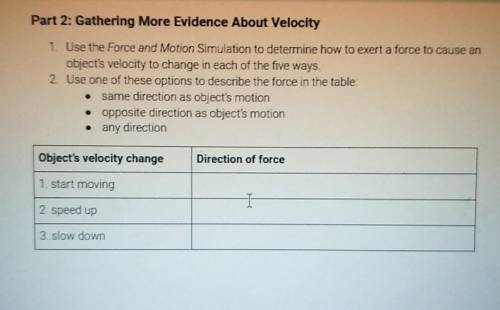
Chemistry, 26.01.2021 07:00 bsheepicornozj0gc
Part 2: Gathering More Evidence About Velocity 1. Use the Force and Motion Simulation to determine how to exert a force to cause an object's velocity to change in each of the five ways. 2. Use one of these options to describe the force in the table: • same direction as object's motion • opposite direction as object's motion • any direction Object's velocity change Direction of force 1. start moving I 2. speed up 3. slow down


Answers: 2
Another question on Chemistry

Chemistry, 22.06.2019 02:30
Which element forms an ionic bond with flourine? 1) fluorine 2) carbon 3) potassium 4) oxygen
Answers: 1

Chemistry, 22.06.2019 08:30
Since the gas in your graduated cylinder is a mixture of butane and water vapor, you must determine the partial pressure of the butane, pbutane, alone. to do this, consult a reference and record the partial pressure of the water vapor, pwater, at the temperature you recorded. use the following formula to compute the partial pressure of the butane. pbutane = atmosphere - pwater use the following combined gas law formula and compute the volume that the butane sample will occupy at stp. (hint: convert both temperatures to kelvin.) pbutane x voriginal = pstandard x vfinal troom tstandard use the following ratio and proportion formula to determine the mass of butane needed to occupy a volume of 22.4 l at stp. grams of butane you used “x” grams of butane ml of butane corrected to stp = 22,400 ml compute the theoretical molar mass of butane based on its formula and the atomic masses on the periodic table. compare your experimental results from #3 to the theoretical value of #4, computing a percent error of your findings using this formula: % error = measured value - accepted value x 100 accepted value use the following ratio and proportion formula to determine the mass of butane needed to occupy a volume of 22.4 l at stp. need asap
Answers: 1

Chemistry, 22.06.2019 10:40
Ammonia and oxygen react to form nitrogen monoxide and water, like this: 4nh3 (g) + 5o2 (g) → 4no (g) + 6h2o (g) also, a chemist finds that at a certain temperature the equilibrium mixture of ammonia, oxygen, nitrogen monoxide, and water has the following composition: compound pressure at equilibrium nh3 65.1atm o2 31.3atm no 62.7atm h2o 65.8atm compound pressure at equilibrium nh3 65.3 atm o2 7.79 atm no 12.1 atm h2o 65.8 atm calculate the value of the equilibrium constant kp for this reaction. round your answer to 2 significant
Answers: 2

You know the right answer?
Part 2: Gathering More Evidence About Velocity 1. Use the Force and Motion Simulation to determine h...
Questions


Mathematics, 11.05.2021 18:40



Mathematics, 11.05.2021 18:40

Biology, 11.05.2021 18:40



History, 11.05.2021 18:40



Mathematics, 11.05.2021 18:40

Mathematics, 11.05.2021 18:40

History, 11.05.2021 18:40

Arts, 11.05.2021 18:40








